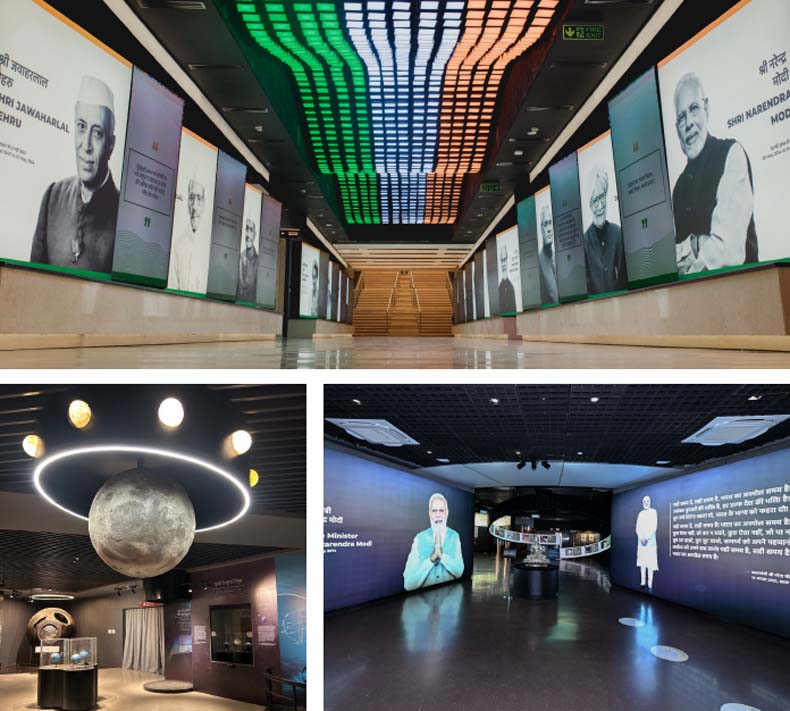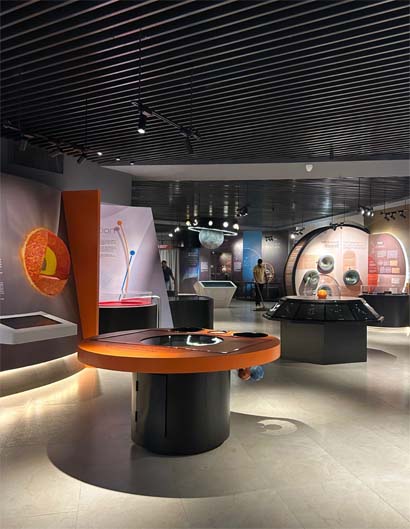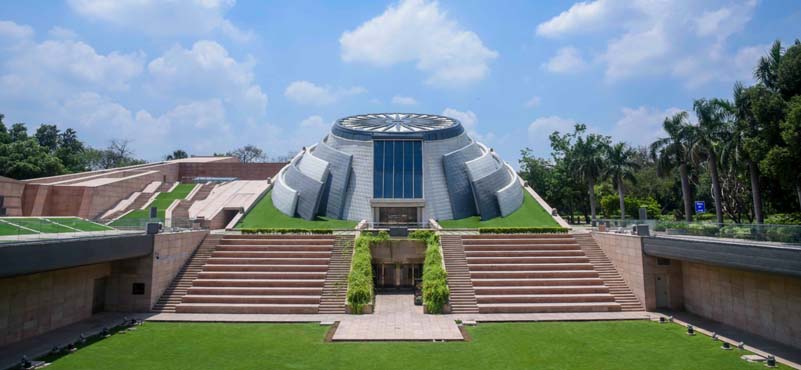Share the post "Exploring the PMML ExperienceHouse of Democracy, a Centre of Research and a Gateway to the Stars"
With inputs from Prime Ministers’ Museum and Library (PMML)
A recent expansion and a revitalised engagement, from an earlier focus on just the first prime minister, to all of them, with India’s history seen through the lives of all – from Pandit Jawaharlal Nehru to PM Vajpayee, Manmohan Singh and Narendra Modi – a rare insight into how our democracy has stood the test of time. A must for every Indian, whether a local in the capital or a visitor from within India, or overseas.
On a quiet morning at Teen Murti Estate in New Delhi, the past and present meet in perfect harmony. The estate lies close to the iconic Teen Murti Chowk, which commemorates the valour of the Indian soldiers who captured Haifa during the First World War. Within Teen Murti Estate’s sprawling lawns, the 14th-century Kushak Mahal (a hunting lodge built in the mid-1300s) stands as a guardian of Delhi’s layered past.
As your gaze shifts, you find yourself before Teen Murti House; once the residence of the British Commander-in-Chief, then the official residence of Jawaharlal Nehru, India’s first Prime Minister. After Jawaharlal Nehru’s passing, it was turned into a memorial museum in 1966, an early attempt to preserve the memory of a leader and a nation in the making, laying the foundation of what we now know as the Prime Ministers’ Museum and Library (PMML).
Over the years, PMML has grown into an internationally reputed centre of modern and contemporary history, research, and public learning. Today, the Pradhanmantri Sangrahalaya, a part of PMML, features two seamlessly integrated museum buildings, state-of-the-art digital displays, and collections of unmatched scale, standing as both a House of Democracy and a Centre of learning.
A Vision Realized
When Hon’ble Prime Minister Narendra Modi inaugurated the Pradhanmantri Sangrahalaya on 14 April 2022, he envisioned it as a tribute to “every Prime Minister of India” and as a space that would inspire future generations to understand the nation’s democratic journey.
The design of the new building takes inspiration from the ‘Dharmachakra’ of the national flag, symbolizing continuity, progress, and the role of leadership in shaping India’s destiny. The heritage building, dedicated to Jawaharlal Nehru, has been modernized, while the new state-of-the-art building connects innovatively through content and architecture. Together, they weave a seamless narrative beginning with India’s Constitution-making and continuing into the contemporary achievements of the world’s largest democracy.
Stories That Speak
Inside the Sangrahalaya, 43 galleries trace the journey of India and its Prime Ministers, from Jawaharlal Nehru to Narendra Modi. Each gallery presents meticulously sourced photographs, documents, videos, newspapers, and artefacts gathered from across India and abroad. Here, history no longer sits silently; it interacts. Touchscreens allow you to flip through vintage headlines, holograms invite you to “walk with a Prime Minister,” and augmented reality kiosks let you reimagine historic milestones.
The Toshakhana, a treasure house, displays personal memorabilia, souvenirs from international visits, handwritten letters, and rare gifts of leaders such as Jawaharlal Nehru, Indira Gandhi, Atal Bihari Vajpayee, Manmohan Singh, and Narendra Modi. These intimate glimpses transform distant public figures into relatable human beings.

Children and young visitors flock to the Anubhuti Zone, where they can take a selfie with a Prime Minister, browse digital flipbooks, and receive digitally recreated autographed letters from past and present Prime Ministers, and even take the Bhavishya Ki Jhalkiyan VR Helicopter Ride —which journeys through India’s ongoing development projects. The AI Holobox allows them to interact with leaders like Vallabhbhai Patel and A.P.J. Abdul Kalam. The Suraksha Ride, at the Modi Gallery, offers a stirring immersive experience of the valour of India’s armed forces.
Adults often linger by the Vision 2047 Wall, a futuristic installation that invites every visitor to imagine India at 100. From kinetic sculptures to rotoscope animations and interactive kiosks, each space encourages a sense of active participation rather than passive observation.
History is often seen as something distant, locked away in books or archives—but here at PMML, it comes alive.
A Living Cultural Space
The Sangrahalaya is not limited to galleries. Evening light and sound shows transform the lawns into an open-air theatre of history. The most acclaimed program, Veeranganaon ki Mahaagatha, brings to life the stories of India’s unsung women warriors. Visitors can opt for combo tickets, spending their day exploring the galleries, and their evening watching history illuminate the grand backdrop of Teen Murti House.
Beyond the Galleries: Library, Archives, and Research & Publications
PMML also houses one of India’s richest libraries, with over 300,000 books, journals, and volumes, a treasure for scholars of modern and contemporary Indian history. It also houses an Archive which constitutes one of the largest repositories of private papers belonging to freedom fighters, diplomats, statesmen, and thinkers. The Oral History Division is equally remarkable, with 1,300 recorded interviews and nearly a thousand transcripts, preserving first-hand accounts of India’s defining moments. The Research and Publications Division brings out scholarly works, including an Occasional Papers series, and the edited ‘Selected Works’ of key leaders. Recognized as an important academic hub, PMML hosts conferences, seminars, book discussions, and a prestigious Fellowship Programme under its Centre for Contemporary Studies, attracting scholars from across the world.
 The Planetarium: The Sky Beckons
The Planetarium: The Sky Beckons
For those seeking a window into the cosmos, the Planetarium within the PMML campus acts as a gateway to the stars. Opened in 1984, it has inspired generations of schoolchildren. In April 2023, it underwent a major upgrade with cutting-edge 3D digital projection technology. From shows on black holes and eclipses to skywatching sessions, peering at Saturn’s rings or lunar phenomena, the Planetarium brings astronomy to life. It is not unusual to see students first walking through the journey of India’s democracy and then looking upward, struck by the sense that our nation’s story is part of the universe’s grand arc. The Planetarium on 23 August 2025 hosted the inauguration of the “Aryabhata Gallery: Story of Astronomy and Space Science” by Group Captain Shubhanshu Shukla (the second Indian to travel into space and the first Indian to dock at the International Space Station), whose interaction with students and reflections on the wonder of space further enriched the experience of young learners.
PMML: A Journey through Time and Space
PMML is a vibrant cultural hub encompassing the Sangrahalaya, a world-class library, an extensive archive, a research institute, and a planetarium — a realm of wonder all under the stewardship of the Prime Minister of India. It dons many roles: a guardian of legacies, a beacon for young minds, a grand stage for culture, and a telescope opening windows to the cosmos.
Whether you walk alongside previous Prime Ministers through the journey of India’s past, take a tour with the present Prime Minister Narendra Modi through India’s growth story, browse through 3 lakh books and invaluable archival documents, listen to the voices of freedom fighters, or lie back under the Planetarium dome to marvel at the Milky Way, PMML offers a rare gift: a journey through time and space, grounded in democracy yet open to the infinite.
Plan your visit
All of this is accessible under one roof at the The Prime Ministers Museum and Library, welcoming visitors throughout the week. The Sangrahalaya is open Tuesday to Sunday, 10:00 AM–6:00 PM, and closed on Mondays and gazetted holidays. Evening Light and Sound Shows bring history to life, with the Hindi show at 7:30–8:00 PM and the English show at 8:15–8:45 PM. The Planetarium dazzles with 2D and 3D shows in English and Hindi throughout the day. The Library is open Monday–Friday, 9:00 AM–8:00 PM, and Saturday, 9:00 AM–5:30 PM (winter timings until 7:00 PM).
Designed with inclusivity in mind, the museum offers wheelchair-friendly premises, free wheelchairs on-site, elevators, ramps, and accessible washrooms. For those with mobility challenges, golf carts are available to help navigate the expansive grounds. A convenient shuttle bus service connects the Sangrahalaya with Udyog Bhawan and Central Secretariat metro stations, making access seamless for visitors. After a day of exploration, guests can also unwind at the cafeteria, a perfect spot to relax and reflect. For more information, one can visit the official website.





